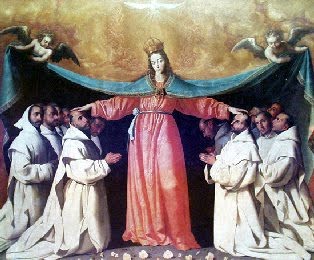 There is a strong sense from this past Sunday's Gospel in both the Ordinary and Extraordinary Forms of Mass that there is an expectation, a longing for a Messiah. We know that liturgically that expectation will be fulfilled in ten days when we celebrate God entering the world as a baby. This brief reflection below is from Dom Augustin Guillerand as he explains the meaning of the Incarnation and how we should apply that to our own life.
There is a strong sense from this past Sunday's Gospel in both the Ordinary and Extraordinary Forms of Mass that there is an expectation, a longing for a Messiah. We know that liturgically that expectation will be fulfilled in ten days when we celebrate God entering the world as a baby. This brief reflection below is from Dom Augustin Guillerand as he explains the meaning of the Incarnation and how we should apply that to our own life. Instead of attempting to free ourselves from the things of the senses, or abstracting from them, we should try to probe deeper into them; not stopping at their external appearance, which changes, but seeking what is hidden deep in their substance: their being, in a word. For God is Being. And thus we shall find Him beneath the veil of the senses.
This is the meaning of the Incarnation. God became tangible, in order to teach us to find Him in all that we touch and see and feel; for we are necessarily bound to the senses in this life. Jesus did not do away with these external contacts; what He taught us is not to stop at them. He taught us to find His Father in everything: in the flowers, in the lilies of the field, in the birds, in sorrow – in everything, because everything comes from His love, and must return to it. Ut dum visibiliter Deum cognoscimus, per hunc in invisibilium amorem rapiamur – In Him we see our God made visible, and so are caught up in the love of the God we cannot see (Preface of Christmas).
We must endeavor, therefore, to cultivate this spiritual “second-sight”. It is the secret of the saints, for whom this world is not an obstacle between their souls and God, but a living image, a resplendent mirror of His goodness and beauty. It is this great Reality, so utterly beyond our conception, that the Incarnation made possible: that by loving and imitating Jesus incarnate, we love and imitate God Himself.
This is the meaning of the Incarnation. God became tangible, in order to teach us to find Him in all that we touch and see and feel; for we are necessarily bound to the senses in this life. Jesus did not do away with these external contacts; what He taught us is not to stop at them. He taught us to find His Father in everything: in the flowers, in the lilies of the field, in the birds, in sorrow – in everything, because everything comes from His love, and must return to it. Ut dum visibiliter Deum cognoscimus, per hunc in invisibilium amorem rapiamur – In Him we see our God made visible, and so are caught up in the love of the God we cannot see (Preface of Christmas).
We must endeavor, therefore, to cultivate this spiritual “second-sight”. It is the secret of the saints, for whom this world is not an obstacle between their souls and God, but a living image, a resplendent mirror of His goodness and beauty. It is this great Reality, so utterly beyond our conception, that the Incarnation made possible: that by loving and imitating Jesus incarnate, we love and imitate God Himself.











